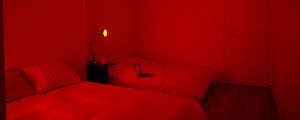In the middle of the Champs-Elysées, atop the much celebrated Louis Vuitton shop and where tourists amass to buy coveted Parisian souvenirs, lies a hidden treasure. Here one will find ‘L’espace culturel Louis Vuitton‘: a center for contemporary arts, offering a surprising and unique program.
To reach ‘L’espace culturel Louis Vuitton’, you must first rid yourself of any inhibitions. As no signs point you in the correct direction, you shall venture to the corner of the shop (and that classy lobby-reception) of rue Bassano and ask the receptionist to show you the way in… Now take a deep breath, as here starts your journey into the world of contemporary art that Vuitton has to offer. The lift – named ‘Your Loss of Senses” by the artist Olafur Eliasson – is in itself part of the experience of L’espace culturel’. Created in 2005 for the opening of the center, it is a curious experience for the senses. Claustrophobics beware! Ascending seven floors in total darknes (the lift is entirely covered in black carpet) with only the few sounds uttered by passengers to break the silence, it is a brief and worthwhile journey for what lies ahead…
If you’ve made it to the 7th floor you’ll reach that unique space of bright light and energy: an amazingly bright room with a spectacular 360 degree view of Paris, where you can enjoy the work of 15 artists gathered for the current exhibition ‘Autobiographies’. This exhibition wants to highlight the different methods artists use to represent their own life… Some artists do so by using systems and inventories. As is the case of Sol Lewitt whose 60 photographic plates overturn our perceived ideas about the personality of the minimalist artist and draw us, through a series of shots of elements of his everyday life (from books to toilet paper, tools or plants) into his very personal world which suddenly becomes very vivid and messy. This obsession of inventories can also be found in On Kawara‘s work. Kawara is renown for his ‘date paintings’ which are represented in the exhibition by a calendar he created to record the days on which he painted them.

Other artists prefer to express themselves through a mix of true accounts and fiction where art and life continuously interpenetrate as is the case in the film diary Walden that Jonas Mekas made between 1964 and 1968. Here we follow the daily life of the artist with his family and friends, including Yoko Ono, John Lennon and Richard Foreman complete with the wonderful energy of the sixties as a background. A similar approach can be found in Sternenstaub by Franz Erhard Walther, where, in compilation of anecdotes, drawings and memories, the artist tells us his life between 1942 and 1973.
Among these autobiographies, a favorite of mine is the sculpture by Italian artist Ernesto Sartori. A wooden structure proud of occupying such space LV cultural space. Being eight Ernesto had an apparition while walking in the mountains, it occurred in the form of a pointed shape, a bipartite vessel that would seal his destiny as an artist. That sculpture « Vaisseau-Horaire » is a reconstruction of this childhood memory, an incredibly naive and touching piece.

All in all it feels like a privilege to be in the presence of all these works while becoming privy to the secrets and fragility of the artists, be it a brother’s illness (as in David B’s work), or a father’s death (Frederic Pajak).
One last worth mentioning work maybe that of young Mélanie Delattre-Vogt; who inspired by family memories and photo albums (as in the series ‘Le père’), creates a substantial and tormented work, the effects of which are only heightened by the use of a simple grey pencil.

If this unique free exhibition doesn’t inspire or stimulate your intellect, or if the chance to appreciate well-established but also very promising names of contemporary art in the same space, fear not as the dark lift awaits to take you back directly to the Louis Vuitton shop. You’ll certainly need one of their big&cheap trunks.
“Autobiographies” is running until May.20th @ Espace Culturel Louis Vuitton – Paris (Free entrance of course)
















